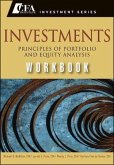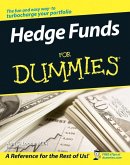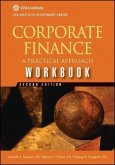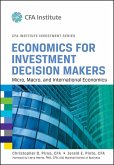Investments (eBook, ePUB)
Principles of Portfolio and Equity Analysis


Alle Infos zum eBook verschenken

Investments (eBook, ePUB)
Principles of Portfolio and Equity Analysis
- Format: ePub
- Merkliste
- Auf die Merkliste
- Bewerten Bewerten
- Teilen
- Produkt teilen
- Produkterinnerung
- Produkterinnerung

Hier können Sie sich einloggen

Bitte loggen Sie sich zunächst in Ihr Kundenkonto ein oder registrieren Sie sich bei bücher.de, um das eBook-Abo tolino select nutzen zu können.
A comprehensive guide to investment analysis and portfolio management by an expert team from the CFA Institute In a world of specialization, no other profession likely requires such broad, yet in-depth knowledge than that of financial analyst. Financial analysts must not only possess a broad understanding of the financial markets-including structure, organization, efficiency, portfolio management, risk and return, and planning and construction-but they must also have a strong sense of how to evaluate industries and companies prior to engaging in an analysis of a specific stock. Investments:…mehr
- Geräte: eReader
- mit Kopierschutz
- eBook Hilfe
- Größe: 11.31MB
![Investments Workbook (eBook, ePUB) Investments Workbook (eBook, ePUB)]() Michael G. McmillianInvestments Workbook (eBook, ePUB)34,99 €
Michael G. McmillianInvestments Workbook (eBook, ePUB)34,99 €![Hedge Funds For Dummies (eBook, ePUB) Hedge Funds For Dummies (eBook, ePUB)]() Ann C. LogueHedge Funds For Dummies (eBook, ePUB)19,99 €
Ann C. LogueHedge Funds For Dummies (eBook, ePUB)19,99 €![Economics for Investment Decision Makers (eBook, ePUB) Economics for Investment Decision Makers (eBook, ePUB)]() Christopher D. PirosEconomics for Investment Decision Makers (eBook, ePUB)34,99 €
Christopher D. PirosEconomics for Investment Decision Makers (eBook, ePUB)34,99 €![Corporate Finance Workbook (eBook, ePUB) Corporate Finance Workbook (eBook, ePUB)]() Michelle R. ClaymanCorporate Finance Workbook (eBook, ePUB)36,99 €
Michelle R. ClaymanCorporate Finance Workbook (eBook, ePUB)36,99 €![The New Wealth Management (eBook, ePUB) The New Wealth Management (eBook, ePUB)]() Harold EvenskyThe New Wealth Management (eBook, ePUB)76,99 €
Harold EvenskyThe New Wealth Management (eBook, ePUB)76,99 €![Corporate Finance (eBook, ePUB) Corporate Finance (eBook, ePUB)]() Michelle R. ClaymanCorporate Finance (eBook, ePUB)76,99 €
Michelle R. ClaymanCorporate Finance (eBook, ePUB)76,99 €![Economics for Investment Decision Makers (eBook, ePUB) Economics for Investment Decision Makers (eBook, ePUB)]() Christopher D. PirosEconomics for Investment Decision Makers (eBook, ePUB)81,99 €
Christopher D. PirosEconomics for Investment Decision Makers (eBook, ePUB)81,99 €-
-
-
Dieser Download kann aus rechtlichen Gründen nur mit Rechnungsadresse in A, B, BG, CY, CZ, D, DK, EW, E, FIN, F, GR, HR, H, IRL, I, LT, L, LR, M, NL, PL, P, R, S, SLO, SK ausgeliefert werden.
- Produktdetails
- Verlag: John Wiley & Sons
- Seitenzahl: 656
- Erscheinungstermin: 12. Januar 2011
- Englisch
- ISBN-13: 9781118001165
- Artikelnr.: 37357812
- Verlag: John Wiley & Sons
- Seitenzahl: 656
- Erscheinungstermin: 12. Januar 2011
- Englisch
- ISBN-13: 9781118001165
- Artikelnr.: 37357812
- Herstellerkennzeichnung Die Herstellerinformationen sind derzeit nicht verfügbar.
Acknowledgments xv
Introduction xvii
Chapter 1 Market Organization and Structure 1
Learning Outcomes 1
1. Introduction 1
2. The Functions of the Financial System 2
2.1. Helping People Achieve Their Purposes in Using the Financial System 3
2.2. Determining Rates of Return 8
2.3. Capital Allocation Efficiency 9
3. Assets and Contracts 10
3.1. Classifications of Assets and Markets 11
3.2. Securities 13
3.3. Currencies 16
3.4. Contracts 16
3.5. Commodities 22
3.6. Real Assets 22
4. Financial Intermediaries 24
4.1. Brokers, Exchanges, and Alternative Trading Systems 25
4.2. Dealers 26
4.3. Securitizers 27
4.4. Depository Institutions and Other Financial Corporations 29
4.5. Insurance Companies 30
4.6. Arbitrageurs 31
4.7. Settlement and Custodial Services 33
4.8. Summary 35
5. Positions 35
5.1. Short Positions 36
5.2. Levered Positions 38
6. Orders 41
6.1. Execution Instructions 42
6.2. Validity Instructions 45
6.3. Clearing Instructions 47
7. Primary Security Markets 47
7.1. Public Offerings 48
7.2. Private Placements and Other Primary Market Transactions 50
7.3. Importance of Secondary Markets to Primary Markets 51
8. Secondary Security Market and Contract Market Structures 51
8.1. Trading Sessions 51
8.2. Execution Mechanisms 52
8.3. Market Information Systems 56
9. Well-Functioning Financial Systems 56
10. Market Regulation 58
11. Summary 61
Problems 63
Chapter 2 Security Market Indices 73
Learning Outcomes 73
1. Introduction 73
2. Index Definition and Calculations of Value and Returns 75
2.1. Calculation of Single-Period Returns 75
2.2. Calculation of Index Values over Multiple Time Periods 77
3. Index Construction and Management 78
3.1. Target Market and Security Selection 79
3.2. Index Weighting 79
3.3. Index Management: Rebalancing and Reconstitution 88
4. Uses of Market Indices 90
4.1. Gauges of Market Sentiment 90
4.2. Proxies for Measuring and Modeling Returns, Systematic Risk, and
Risk-Adjusted Performance 90
4.3. Proxies for Asset Classes in Asset Allocation Models 90
4.4. Benchmarks for Actively Managed Portfolios 91
4.5. Model Portfolios for Investment Products 91
5. Equity Indices 91
5.1. Broad Market Indices 91
5.2. Multimarket Indices 92
5.3. Sector Indices 92
5.4. Style Indices 93
6. Fixed-Income Indices 94
6.1. Construction 94
6.2. Types of Fixed-Income Indices 95
7. Indices for Alternative Investments 96
7.1. Commodity Indices 98
7.2. Real Estate Investment Trust Indices 98
7.3. Hedge Fund Indices 98
8. Summary 101
Problems 102
Chapter 3 Market Efficiency 109
Learning Outcomes 109
1. Introduction 109
2. The Concept of Market Efficiency 111
2.1. The Description of Efficient Markets 111
2.2. Market Value versus Intrinsic Value 113
2.3. Factors Contributing to and Impeding a Market's Efficiency 114
2.4. Transaction Costs and Information-Acquisition Costs 117
3. Forms of Market Efficiency 118
3.1. Weak Form 119
3.2. Semistrong Form 119
3.3. Strong Form 122
3.4. Implications of the Efficient Market Hypothesis 122
4. Market Pricing Anomalies 124
4.1. Time-Series Anomalies 125
4.2. Cross-Sectional Anomalies 127
4.3. Other Anomalies 128
4.4. Implications for Investment Strategies 130
5. Behavioral Finance 131
5.1. Loss Aversion 131
5.2. Overconfidence 132
5.3. Other Behavioral Biases 132
5.4. Information Cascades 133
5.5. Behavioral Finance and Efficient Markets 133
6. Summary 134
Problems 134
Chapter 4 Portfolio Management: An Overview 139
Learning Outcomes 139
1. Introduction 139
2. A Portfolio Perspective on Investing 140
2.1. Portfolio Diversification: Avoiding Disaster 140
2.2. Portfolios: Reduce Risk 142
2.3. Portfolios: Composition Matters for the Risk-Return Tradeoff 145
2.4. Portfolios: Not Necessarily Downside Protection 145
2.5. Portfolios: The Emergence of Modern Portfolio Theory 148
3. Investment Clients 149
3.1. Individual Investors 149
3.2. Institutional Investors 150
4. Steps in the Portfolio Management Process 156
4.1. Step One: The Planning Step 156
4.2. Step Two: The Execution Step 156
4.3. Step Three: The Feedback Step 159
5. Pooled Investments 160
5.1. Mutual Funds 160
5.2. Types of Mutual Funds 164
5.3. Other Investment Products 167
6. Summary 172
Problems 172
Chapter 5 Portfolio Risk and Return: Part I 175
Learning Outcomes 175
1. Introduction 175
2. Investment Characteristics of Assets 176
2.1. Return 176
2.2. Other Major Return Measures and Their Applications 185
2.3. Variance and Covariance of Returns 189
2.4. Historical Return and Risk 192
2.5. Other Investment Characteristics 197
3. Risk Aversion and Portfolio Selection 200
3.1. The Concept of Risk Aversion 201
3.2. Utility Theory and Indifference Curves 202
3.3. Application of Utility Theory to Portfolio Selection 206
4. Portfolio Risk 209
4.1. Portfolio of Two Risky Assets 210
4.2. Portfolio of Many Risky Assets 215
4.3. The Power of Diversification 216
5. Efficient Frontier and Investor's Optimal Portfolio 222
5.1. Investment Opportunity Set 222
5.2. Minimum-Variance Portfolios 223
5.3. A Risk-Free Asset and Many Risky Assets 225
5.4. Optimal Investor Portfolio 228
6. Summary 234
Problems 234
Chapter 6 Portfolio Risk and Return: Part II 243
Learning Outcomes 243
1. Introduction 243
2. Capital Market Theory 244
2.1. Portfolio of Risk-Free and Risky Assets 244
2.2. The Capital Market Line 248
3. Pricing of Risk and Computation of Expected Return 256
3.1. Systematic Risk and Nonsystematic Risk 257
3.2. Calculation and Interpretation of Beta 259
4. The Capital Asset Pricing Model 267
4.1. Assumptions of the CAPM 267
4.2. The Security Market Line 269
4.3. Applications of the CAPM 272
5. Beyond the Capital Asset Pricing Model 284
5.1. The CAPM 284
5.2. Limitations of the CAPM 284
5.3. Extensions to the CAPM 286
5.4. The CAPM and Beyond 287
6. Summary 287
Problems 288
Chapter 7 Basics of Portfolio Planning and Construction 295
Learning Outcomes 295
1. Introduction 295
2. Portfolio Planning 296
2.1. The Investment Policy Statement 296
2.2. Major Components of an IPS 297
2.3. Gathering Client Information 309
3. Portfolio Construction 312
3.1. Capital Market Expectations 312
3.2. The Strategic Asset Allocation 313
3.3. Steps toward an Actual Portfolio 321
3.4. Additional Portfolio Organizing Principles 325
4. Summary 326
Problems 327
Chapter 8 Overview of Equity Securities 331
Learning Outcomes 331
1. Introduction 331
2. Equity Securities in Global Financial Markets 332
3. Types and Characteristics of Equity Securities 338
3.1. Common Shares 339
3.2. Preference Shares 343
4. Private versus Public Equity Securities 345
5. Investing in Nondomestic Equity Securities 347
5.1. Direct Investing 348
5.2. Depository Receipts 349
6. Risk and Return Characteristics of Equity Securities 353
6.1. Return Characteristics of Equity Securities 353
6.2. Risk of Equity Securities 354
7. Equity Securities and Company Value 356
7.1. Accounting Return on Equity 356
7.2. The Cost of Equity and Investors' Required Rates of Return 361
8. Summary 362
Problems 363
Chapter 9 Introduction to Industry and Company Analysis 369
Learning Outcomes 369
1. Introduction 370
2. Uses of Industry Analysis 370
3. Approaches to Identifying Similar Companies 371
3.1. Products and/or Services Supplied 371
3.2. Business-Cycle Sensitivities 372
3.3. Statistical Similarities 374
4. Industry Classification Systems 374
4.1. Commercial Industry Classification Systems 374
4.2. Governmental Industry Classification Systems 378
4.3. Strengths and Weaknesses of Current Systems 380
4.4. Constructing a Peer Group 380
5. Describing and Analyzing an Industry 385
5.1. Principles of Strategic Analysis 386
5.2. External Influences on Industry Growth, Profitability, and Risk 405
6. Company Analysis 412
6.1. Elements That Should Be Covered in a Company Analysis 413
6.2. Spreadsheet Modeling 416
7. Summary 417
Problems 420
Chapter 10 Equity Valuation: Concepts and Basic Tools 425
Learning Outcomes 425
1. Introduction 426
2. Estimated Value and Market Price 426
3. Major Categories of Equity Valuation Models 428
4. Present Value Models: The Dividend Discount Model 430
4.1. Preferred Stock Valuation 434
4.2. The Gordon Growth Model 436
4.3. Multistage Dividend Discount Models 441
5. Multiplier Models 445
5.1. Relationships among Price Multiples, Present Value Models, and
Fundamentals 445
5.2. The Method of Comparables 449
5.3. Illustration of a Valuation Based on Price Multiples 452
5.4. Enterprise Value 454
6. Asset-Based Valuation 457
7. Summary 461
Problems 462
Chapter 11 Equity Market Valuation 469
Learning Outcomes 469
1. Introduction 469
2. Estimating a Justified P/E Ratio 470
2.1. Neoclassical Approach to Growth Accounting 470
2.2. The China Economic Experience 472
2.3. Quantifying China's Future Economic Growth 474
2.4. Equity Market Valuation 476
3. Top-Down and Bottom-Up Forecasting 484
3.1. Portfolio Suitability of Each Forecasting Type 485
3.2. Using Both Forecasting Types 487
3.3. Top-Down and Bottom-Up Forecasting of Market Earnings per Share 488
4. Relative Value Models 491
4.1. Earnings-Based Models 491
4.2. Asset-Based Models 502
5. Summary 506
Problems 508
Chapter 12 Technical Analysis 515
Learning Outcomes 515
1. Introduction 515
2. Technical Analysis: Definition and Scope 516
2.1. Principles and Assumptions 516
2.2. Technical and Fundamental Analysis 518
3. Technical Analysis Tools 520
3.1. Charts 520
3.2. Trend 530
3.3. Chart Patterns 532
3.4. Technical Indicators 544
3.5. Cycles 562
4. Elliott Wave Theory 563
5. Intermarket Analysis 566
6. Summary 568
Problems 570
Glossary 575
References 589
About the Authors 595
About the CFA Program 601
Index 603
Acknowledgments xv
Introduction xvii
Chapter 1 Market Organization and Structure 1
Learning Outcomes 1
1. Introduction 1
2. The Functions of the Financial System 2
2.1. Helping People Achieve Their Purposes in Using the Financial System 3
2.2. Determining Rates of Return 8
2.3. Capital Allocation Efficiency 9
3. Assets and Contracts 10
3.1. Classifications of Assets and Markets 11
3.2. Securities 13
3.3. Currencies 16
3.4. Contracts 16
3.5. Commodities 22
3.6. Real Assets 22
4. Financial Intermediaries 24
4.1. Brokers, Exchanges, and Alternative Trading Systems 25
4.2. Dealers 26
4.3. Securitizers 27
4.4. Depository Institutions and Other Financial Corporations 29
4.5. Insurance Companies 30
4.6. Arbitrageurs 31
4.7. Settlement and Custodial Services 33
4.8. Summary 35
5. Positions 35
5.1. Short Positions 36
5.2. Levered Positions 38
6. Orders 41
6.1. Execution Instructions 42
6.2. Validity Instructions 45
6.3. Clearing Instructions 47
7. Primary Security Markets 47
7.1. Public Offerings 48
7.2. Private Placements and Other Primary Market Transactions 50
7.3. Importance of Secondary Markets to Primary Markets 51
8. Secondary Security Market and Contract Market Structures 51
8.1. Trading Sessions 51
8.2. Execution Mechanisms 52
8.3. Market Information Systems 56
9. Well-Functioning Financial Systems 56
10. Market Regulation 58
11. Summary 61
Problems 63
Chapter 2 Security Market Indices 73
Learning Outcomes 73
1. Introduction 73
2. Index Definition and Calculations of Value and Returns 75
2.1. Calculation of Single-Period Returns 75
2.2. Calculation of Index Values over Multiple Time Periods 77
3. Index Construction and Management 78
3.1. Target Market and Security Selection 79
3.2. Index Weighting 79
3.3. Index Management: Rebalancing and Reconstitution 88
4. Uses of Market Indices 90
4.1. Gauges of Market Sentiment 90
4.2. Proxies for Measuring and Modeling Returns, Systematic Risk, and
Risk-Adjusted Performance 90
4.3. Proxies for Asset Classes in Asset Allocation Models 90
4.4. Benchmarks for Actively Managed Portfolios 91
4.5. Model Portfolios for Investment Products 91
5. Equity Indices 91
5.1. Broad Market Indices 91
5.2. Multimarket Indices 92
5.3. Sector Indices 92
5.4. Style Indices 93
6. Fixed-Income Indices 94
6.1. Construction 94
6.2. Types of Fixed-Income Indices 95
7. Indices for Alternative Investments 96
7.1. Commodity Indices 98
7.2. Real Estate Investment Trust Indices 98
7.3. Hedge Fund Indices 98
8. Summary 101
Problems 102
Chapter 3 Market Efficiency 109
Learning Outcomes 109
1. Introduction 109
2. The Concept of Market Efficiency 111
2.1. The Description of Efficient Markets 111
2.2. Market Value versus Intrinsic Value 113
2.3. Factors Contributing to and Impeding a Market's Efficiency 114
2.4. Transaction Costs and Information-Acquisition Costs 117
3. Forms of Market Efficiency 118
3.1. Weak Form 119
3.2. Semistrong Form 119
3.3. Strong Form 122
3.4. Implications of the Efficient Market Hypothesis 122
4. Market Pricing Anomalies 124
4.1. Time-Series Anomalies 125
4.2. Cross-Sectional Anomalies 127
4.3. Other Anomalies 128
4.4. Implications for Investment Strategies 130
5. Behavioral Finance 131
5.1. Loss Aversion 131
5.2. Overconfidence 132
5.3. Other Behavioral Biases 132
5.4. Information Cascades 133
5.5. Behavioral Finance and Efficient Markets 133
6. Summary 134
Problems 134
Chapter 4 Portfolio Management: An Overview 139
Learning Outcomes 139
1. Introduction 139
2. A Portfolio Perspective on Investing 140
2.1. Portfolio Diversification: Avoiding Disaster 140
2.2. Portfolios: Reduce Risk 142
2.3. Portfolios: Composition Matters for the Risk-Return Tradeoff 145
2.4. Portfolios: Not Necessarily Downside Protection 145
2.5. Portfolios: The Emergence of Modern Portfolio Theory 148
3. Investment Clients 149
3.1. Individual Investors 149
3.2. Institutional Investors 150
4. Steps in the Portfolio Management Process 156
4.1. Step One: The Planning Step 156
4.2. Step Two: The Execution Step 156
4.3. Step Three: The Feedback Step 159
5. Pooled Investments 160
5.1. Mutual Funds 160
5.2. Types of Mutual Funds 164
5.3. Other Investment Products 167
6. Summary 172
Problems 172
Chapter 5 Portfolio Risk and Return: Part I 175
Learning Outcomes 175
1. Introduction 175
2. Investment Characteristics of Assets 176
2.1. Return 176
2.2. Other Major Return Measures and Their Applications 185
2.3. Variance and Covariance of Returns 189
2.4. Historical Return and Risk 192
2.5. Other Investment Characteristics 197
3. Risk Aversion and Portfolio Selection 200
3.1. The Concept of Risk Aversion 201
3.2. Utility Theory and Indifference Curves 202
3.3. Application of Utility Theory to Portfolio Selection 206
4. Portfolio Risk 209
4.1. Portfolio of Two Risky Assets 210
4.2. Portfolio of Many Risky Assets 215
4.3. The Power of Diversification 216
5. Efficient Frontier and Investor's Optimal Portfolio 222
5.1. Investment Opportunity Set 222
5.2. Minimum-Variance Portfolios 223
5.3. A Risk-Free Asset and Many Risky Assets 225
5.4. Optimal Investor Portfolio 228
6. Summary 234
Problems 234
Chapter 6 Portfolio Risk and Return: Part II 243
Learning Outcomes 243
1. Introduction 243
2. Capital Market Theory 244
2.1. Portfolio of Risk-Free and Risky Assets 244
2.2. The Capital Market Line 248
3. Pricing of Risk and Computation of Expected Return 256
3.1. Systematic Risk and Nonsystematic Risk 257
3.2. Calculation and Interpretation of Beta 259
4. The Capital Asset Pricing Model 267
4.1. Assumptions of the CAPM 267
4.2. The Security Market Line 269
4.3. Applications of the CAPM 272
5. Beyond the Capital Asset Pricing Model 284
5.1. The CAPM 284
5.2. Limitations of the CAPM 284
5.3. Extensions to the CAPM 286
5.4. The CAPM and Beyond 287
6. Summary 287
Problems 288
Chapter 7 Basics of Portfolio Planning and Construction 295
Learning Outcomes 295
1. Introduction 295
2. Portfolio Planning 296
2.1. The Investment Policy Statement 296
2.2. Major Components of an IPS 297
2.3. Gathering Client Information 309
3. Portfolio Construction 312
3.1. Capital Market Expectations 312
3.2. The Strategic Asset Allocation 313
3.3. Steps toward an Actual Portfolio 321
3.4. Additional Portfolio Organizing Principles 325
4. Summary 326
Problems 327
Chapter 8 Overview of Equity Securities 331
Learning Outcomes 331
1. Introduction 331
2. Equity Securities in Global Financial Markets 332
3. Types and Characteristics of Equity Securities 338
3.1. Common Shares 339
3.2. Preference Shares 343
4. Private versus Public Equity Securities 345
5. Investing in Nondomestic Equity Securities 347
5.1. Direct Investing 348
5.2. Depository Receipts 349
6. Risk and Return Characteristics of Equity Securities 353
6.1. Return Characteristics of Equity Securities 353
6.2. Risk of Equity Securities 354
7. Equity Securities and Company Value 356
7.1. Accounting Return on Equity 356
7.2. The Cost of Equity and Investors' Required Rates of Return 361
8. Summary 362
Problems 363
Chapter 9 Introduction to Industry and Company Analysis 369
Learning Outcomes 369
1. Introduction 370
2. Uses of Industry Analysis 370
3. Approaches to Identifying Similar Companies 371
3.1. Products and/or Services Supplied 371
3.2. Business-Cycle Sensitivities 372
3.3. Statistical Similarities 374
4. Industry Classification Systems 374
4.1. Commercial Industry Classification Systems 374
4.2. Governmental Industry Classification Systems 378
4.3. Strengths and Weaknesses of Current Systems 380
4.4. Constructing a Peer Group 380
5. Describing and Analyzing an Industry 385
5.1. Principles of Strategic Analysis 386
5.2. External Influences on Industry Growth, Profitability, and Risk 405
6. Company Analysis 412
6.1. Elements That Should Be Covered in a Company Analysis 413
6.2. Spreadsheet Modeling 416
7. Summary 417
Problems 420
Chapter 10 Equity Valuation: Concepts and Basic Tools 425
Learning Outcomes 425
1. Introduction 426
2. Estimated Value and Market Price 426
3. Major Categories of Equity Valuation Models 428
4. Present Value Models: The Dividend Discount Model 430
4.1. Preferred Stock Valuation 434
4.2. The Gordon Growth Model 436
4.3. Multistage Dividend Discount Models 441
5. Multiplier Models 445
5.1. Relationships among Price Multiples, Present Value Models, and
Fundamentals 445
5.2. The Method of Comparables 449
5.3. Illustration of a Valuation Based on Price Multiples 452
5.4. Enterprise Value 454
6. Asset-Based Valuation 457
7. Summary 461
Problems 462
Chapter 11 Equity Market Valuation 469
Learning Outcomes 469
1. Introduction 469
2. Estimating a Justified P/E Ratio 470
2.1. Neoclassical Approach to Growth Accounting 470
2.2. The China Economic Experience 472
2.3. Quantifying China's Future Economic Growth 474
2.4. Equity Market Valuation 476
3. Top-Down and Bottom-Up Forecasting 484
3.1. Portfolio Suitability of Each Forecasting Type 485
3.2. Using Both Forecasting Types 487
3.3. Top-Down and Bottom-Up Forecasting of Market Earnings per Share 488
4. Relative Value Models 491
4.1. Earnings-Based Models 491
4.2. Asset-Based Models 502
5. Summary 506
Problems 508
Chapter 12 Technical Analysis 515
Learning Outcomes 515
1. Introduction 515
2. Technical Analysis: Definition and Scope 516
2.1. Principles and Assumptions 516
2.2. Technical and Fundamental Analysis 518
3. Technical Analysis Tools 520
3.1. Charts 520
3.2. Trend 530
3.3. Chart Patterns 532
3.4. Technical Indicators 544
3.5. Cycles 562
4. Elliott Wave Theory 563
5. Intermarket Analysis 566
6. Summary 568
Problems 570
Glossary 575
References 589
About the Authors 595
About the CFA Program 601
Index 603







